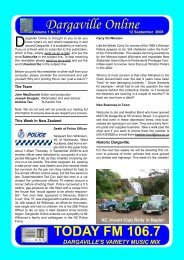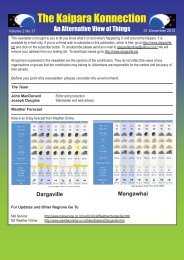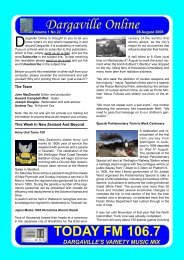The Kaipara Konnection - Kaipara Konnection - Dargaville.BIZ
The Kaipara Konnection - Kaipara Konnection - Dargaville.BIZ
The Kaipara Konnection - Kaipara Konnection - Dargaville.BIZ
You also want an ePaper? Increase the reach of your titles
YUMPU automatically turns print PDFs into web optimized ePapers that Google loves.
Faith is taking the first step, even when<br />
you don’t see the whole staircase. -- Martin Luther King Jr.<br />
4 March 1855 Legendary sheep rustler James Mackenzie caught<br />
In 1855 James Mackenzie became one of New Zealand’s most enduring folk heroes. On 4 March he was caught in a<br />
pass in the upper Waitaki River basin with 1000 sheep that had gone missing from the Levels station, north of Timaru.<br />
While Mackenzie was in possession of the sheep, there were tracks belonging to several other men. He denied the<br />
theft, claiming that he had been hired by John Mossman to drive the sheep to Otago. Mackenzie escaped and walked<br />
160 km to Lyttelton, where he was recaptured on 15 March. In April he was found guilty by a Supreme Court jury and<br />
sentenced to five years’ hard labour.<br />
Mackenzie escaped from his road gang in May and again in June 1855, for only a few days each time. He was placed in<br />
irons and carefully watched. In September a new resident magistrate at Christchurch investigated Mackenzie’s case and<br />
found flaws in both the police inquiry and the trial. As a result Mackenzie was pardoned in January 1856. He probably<br />
returned to Australia, but nothing certain is known of his later life. He left his mark on the South Island high country,<br />
though. <strong>The</strong> significance of the pass where he was discovered with the sheep, and of the pastoral country it led to, were<br />
quickly appreciated by pastoralists. <strong>The</strong> region was subsequently dubbed the Mackenzie Country.<br />
A later biographer, Cathy Marr, says that ‘Mackenzie’s exploits won him the admiration of those on the margins<br />
of society’. He was a hero to many would-be farmers of small means. Those who resented the power of wealthy<br />
landowners also identified with him, and his rebellious spirit inspired many who did not<br />
fit easily into genteel Canterbury society. His pardon won popular sympathy in a frontier<br />
society still engaged in establishing its social and political norms. His life took on legendary<br />
proportions. His almost superhuman strength and a ‘fabulous’ dog saw him held up as<br />
shepherd, drover and thief extraordinaire.<br />
Image: notice of reward for capture of James McKenzie in the Lyttelton Times<br />
8 March 1929 First ‘talkie’ draws huge crowds in Wellington<br />
Moviegoers flocked to see Frank Borzage’s Street angel, a silent picture with a recorded musical soundtrack, at<br />
Wellington’s Paramount <strong>The</strong>atre. <strong>The</strong>re were also five ‘talkie shorts’, including an interview with the King of Spain. Silent<br />
movies were usually accompanied by live music, so a recorded soundtrack was a real novelty.<br />
Street angel told the story of a ‘spirited young woman’, Angela (Janet Gaynor). Down on her luck and living on the<br />
streets, she joined a travelling carnival, where she met a vagabond painter, Gino (Charles Farrell). Gaynor won the Best<br />
Actress Oscar for her performance.<br />
<strong>The</strong> first feature-length movie originally presented as a talkie was <strong>The</strong> jazz singer,<br />
released in the United States in October 1927. Not all were convinced by the new<br />
technology. United Artists president Joseph Schenck asserted in 1928 that the new talkies<br />
were just a passing fad, but by the following year virtually every American film had a<br />
recorded soundtrack. <strong>The</strong> first New Zealand-made talkie screened in January 1930 and<br />
by the early 1930s they were a global phenomenon.<br />
Image: Janet Gaynor in a scene from Street angel (IMDB)<br />
Reference: New Zealand History Online
















